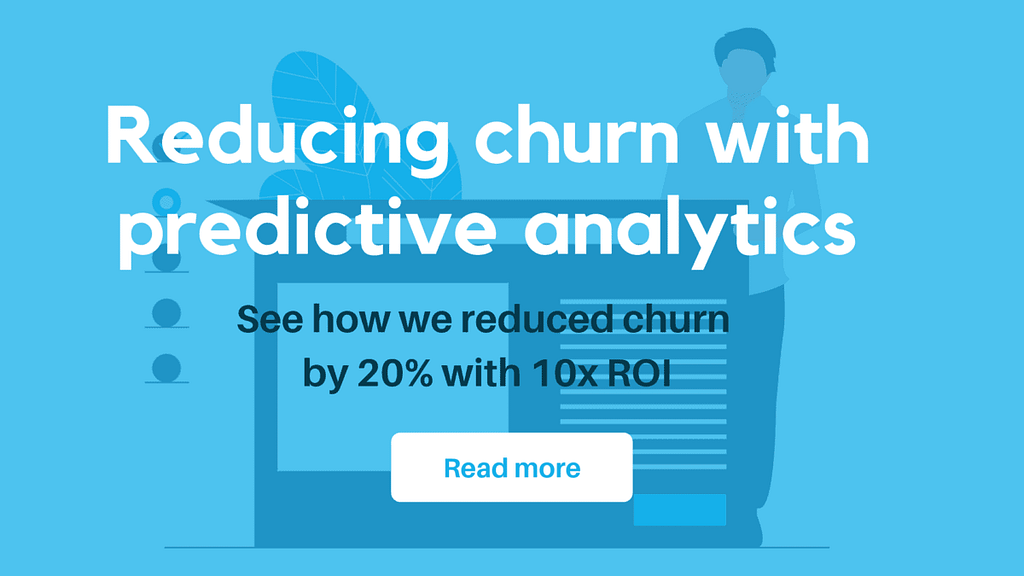Artificial intelligence is becoming a crucial part of many businesses, no matter the industry. The use of machine learning algorithms in telecom is increasingly popular, too, and it’s really quite easy to see why. Telecom companies deal with vast amounts of data and need to drive conclusions from it – which is overwhelmingly difficult to do manually.
Telecoms are no longer limited to providing basic telephone and internet services. In the era of IoT (Internet of Things), there are more and more possibilities. So now you get a smartphone (telephone and internet services), plus broadband, and a Netflix subscription, connected devices – say a smartwatch, and so on. With the growing number of opportunities and so much data, it’s clear that all this information can easily get out of control.
Regaining control
Machine learning algorithms allow companies to regain control over what’s done with available data – or sometimes gain such control for the first time ever. This is crucial, since business decisions, in general, should be based on real information, not a gut feeling.
If you see data clearly – and trust me, data is often a mess – and you understand it, you can make well-informed decisions. Can you see the importance of that in the sales process?
Let’s stop for a moment, I want you to remember the last time a telecom company called you. You probably received at least one generic call from a call center consultant in the past months. Did it go like this?
- Hi, my name is Joan, is this Mr. White? I’m calling from SuperCall telecom services and I’d like to tell you more about our new offer. (…)
Generic. We’ve all been there. Now, when you realize that your service provider has all the information about you: what services you’ve used, what contracts you’ve terminated, where you live, how you move around their website – how the hell don’t they know they shouldn’t be calling you about mobile internet because you’ve already got it and you can’t do anything about your current contract for the next 10 months?
I’m guessing (actually, it’s more than a guess, we’ve checked it) they don’t connect the dots. They don’t see that you visited their point of sale last week. They don’t know what products you’ve been browsing on their website. Well, they know, but this information gets lost in the mess. So a call center consultant will call you in these situations: a) when your contract is about to expire, b) when they’ve got a new great offer (e.g. a new product or subscription).
Now, especially if you are a telecom yourself (a representative thereof, not the whole company, obviously), repeat after me: personalized customer experience is the key.
This is your mantra now. You know what to do now.
Oh, you don’t? No worries, it’s not that obvious at all. Let me walk you through some of the most important use cases of AI in telecom and the opportunities they bring.

Radical personalization
So radical that it’s creepy when you know too much about it. (Just kidding.)
Radical personalization is the use of AI technologies and big data to process data from various sources to make up personal profiles. These profiles are detailed and microtargeted to allow for high accuracy – the more information about the customer, the better. With this personalized approach, companies can automatically generate recommendations for every user – what they will want to buy and at what price. These recommendations can be used both online (“you may also like” sections on the website, recommended products in the app, suggestions made by a chatbot, emailing) or offline (phone calls, points of sale).
How does it work? In simple terms, you collect data about your users – who they are and what they like. A profile of a user is built – so you know that customer 1234 (let’s say that’s the client ID here) lives in a big city, is 30 years old, pays 100 dollars monthly for subscriptions (phone, internet, entertainment), has a smartphone, laptop, smartwatch, and likes watching Amazon Prime. Oh, how much you can do with such information! In this case, the call center consultant, or a sales representative, no longer calls with a random, generic offer, but calls and says: Hi, Mr. White, I see your contract is about to expire, what would you say to a new contract with Amazon Prime at this great price on top of your usual services? – Mind that I’m not a sales representative. I’m pretty sure a sales rep would find a way to say it better 😉
Recommendations have a plethora of advantages: displaying more products to customers and allowing them to discover interesting products or content, improved (and personalized) customer experience and higher customer satisfaction, a higher number of items added to cart – and that translates into more revenue. Recommendations are a win-win: they’re great for both the customers and companies. Customers see more relevant content – they don’t get lost in long lists of products or articles. They see what matters to them. They’re more likely to buy more or stay online longer, and they’re happier with the experience they had with a given company. The company, in turn, collects data about user behaviors (which is extremely valuable!) and is able to sell more. Everybody’s happy.
Churn prediction
Churn prediction is about finding those customers who are unhappy. Churn, or the loss of customers, is a major problem for many service providers and it’s often difficult to solve – especially since many businesses use rather ineffective customer retention strategies. Churn prediction is about analyzing relevant data to identify factors indicating that a given customer is a flight risk. If you know which customers are about to cancel their subscription or terminate their contract, you can take proactive measures and prevent them from leaving. In our project for a large national telecom, the goal was to reduce churn by 2 percentage points in the segment where it was the highest. During the pilot, we managed to save our client $39k monthly. We reduced churn by 20%, and the client ended up with 10x return on investment.
How does it work? Usually, call center staff randomly contact those customers whose contracts are about to expire. While it may be a successful strategy for some customers, many consumers find these calls frustrating, especially if they’ve already expressed interest (or the lack of it) in signing a new contract. Or they’ve already been called by another representative. Making use of available data, companies can accurately identify the segments of customers at the highest risk of leaving, thus preventing the loss of revenue and making sure that the costs of acquiring such a customer aren’t higher than the customer’s value.
- How we reduced churn in a telecom company by 20% in less than 6 months using predictive models
- How predictive models help businesses: reducing churn by more than 20% with 10x ROI
- Predictive analytics for business: How to use recommender systems, dynamic pricing, and churn prediction to drive business results
Price optimization
The telecom industry is very competitive and the demand can change rapidly. Service providers used to compete on the minute price, but now, with unlimited call time in subscriptions, other factors come into play. Different telecoms usually offer very similar, if not the same, services and products, so they have to play with their prices and adjust to market changes fast if they want to maintain or extend their market share. Now, it’s easy to assume that the right strategy is to have a lower price than your competitor – but this means that you’ll sell your services for less even if the customer was willing to pay more. With well-built customer profiles, you know what price you can offer. Can the service be any cheaper? Is the offer right for this customer? How’s your offer compared with your competitors’ prices? There are numerous factors that can influence the price being just right. Dynamic pricing is a strategy utilizing machine learning to allow companies to monitor and adjust prices more effectively. It’s a solution frequently used by airlines, hotels, or retailers, now becoming more popular in the telecom industry as well. In dynamic pricing, algorithms analyze historical and competitive data to make accurate pricing recommendations and sales predictions.
Read more about dynamic pricing:
Dynamic pricing in practice: Is it for everyone?
Predicting consumer behavior
To market products or services just right in order to encourage more people to become customers, you need thorough market research – and you need to be able to predict consumer behavior. Steve Jobs said:
People don’t know what they want until you show it to them.
So it’s our job as marketers to know what they want before they do – so we can show it to them and make them realize that this thing is what they need. But how do you do that? If you have to figure it out before they do, you can’t simply ask. Guessing is too much of a risk. Market research reveals a part of what the customers want – but you can’t rely solely on history if you want to see innovation. Plus, people often provide false information, be it intentionally or not. When you study the market, you have a closer look at existing customers, and while that’s still significant, you need to study the non-buyers too. You can’t only look at the data your current customers leave behind – you should also trace the digital footprints of your prospective buyers. Analyzing customer behavior helps segment customers, target them with the right offers, improve retention. And there’s also that magical factor of AI – it does not only give insight into the current state, it can also predict future trends and outcomes. This way, predictive models will accurately show the customers at the risk of churning – as described earlier in this article. Predictive marketing has already been around for a while and has proven it’s worth. According to Forbes, predictive marketing initiatives that have been underway for some time are delivering impressive results. A vast majority of executives who have been overseeing predictive marketing efforts for at least two years (86%) report increased return on investment (ROI) as a result of their predictive marketing.
Telecom + AI = perfect match?
Definitely. Telecom companies collect lots of extremely valuable data that can help improve the efficiency of marketing efforts, boost sales, improve retention, and generally lead to an increase in revenue. In a data-driven world, any company that fails to keep up with the tech risks never catching up, and in a business like telecom, there is no space for guesswork. The extremely competitive market requires companies to make data-driven decisions in order to stay alive.

